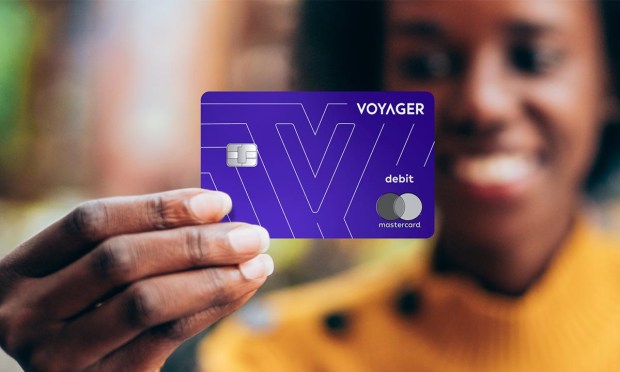Mastercard, Voyager Team to Make USDC Stablecoin Spendable and Mainstream

“We live in a digital money world.”
Steve Ehrlich, CEO at cryptocurrency platform Voyager Digital, told Karen Webster that as cash use dwindles, and as consumers use credit and debit cards to move money electronically, the stage is being set for a wider embrace of cryptocurrencies for everyday spending.
The desire to do so is there. As PYMNTS research has shown, as much as 18% of the U.S. population would like to use cryptocurrency to make a purchase.
Read more: BitPay Study: How Consumers Want to Use Crypto to Shop and Pay in 2021 and After
On Tuesday (Nov. 16), Voyager announced the availability of a debit card in partnership with Mastercard that the company has said earns high returns on crypto assets held with the firm — in particular, USDC stablecoins — that can be spent like cash everywhere debit Mastercard is accepted. Unique to the new Voyager card will be its use of a stablecoin while offering annual rewards to all participating customers.
In terms of the mechanics of the Voyager Debit Card, users are rewarded by holding balances, and are given USD Coin in their accounts, in addition to a 9% yield. The card comes with a unique routing and account number, giving users the ability to use features like automatic bill pay, direct deposit, and ATM deposits and withdrawals.
“This will bring to our consumers — and future customers — a debit card that is tied to their USDC balances held at Voyager,” said Ehrlich. “Cardholders can earn their annual rewards that are paid monthly by holding USDC with us, but then use that debit card anywhere that Mastercard is accepted. You can spend just as you would if you were using a card from a traditional bank.”
The Stablecoin Advantage — and the Mechanics
Stablecoins are in their nascent stage, though are rapidly gaining adoption. Circle recently noted that there is $33 billion worth of USDC in circulation. And with a nod to the ongoing regulatory picture, Ehrlich noted that frameworks and standards will help the digital assets become more widely adopted as a payment mechanism. “Thoughtful regulation could be very powerful in the adoption phase here,” he told Webster.
In terms of mechanics, cardholders swipe the debit card or spend online, and Voyager does “all the backend work” that takes the USDC, turns the stablecoins into dollars and pays the vendor in fiat. The new card makes Voyager the first crypto company to bring USDC fully into the commerce marketplace, Ehrlich said — and that solves a point of friction for cryptos and stablecoins in general.
As Ehrlich noted, consumers want to be able to spend their USDC holdings, and tend to want to hold onto their bitcoin gains. Bitcoin holders generally want to hold that marquee crypto name, viewing bitcoin as less of a spendable asset than a store of value and long-term growth.
Bitcoin is also less attractive as a payments choice, said Ehrlich, due to the taxes tied to capital gains, as that tax event is not levied on stablecoins, which trade at parity with fiat.
Embracing Yield
And, Ehrlich added, cryptocurrency holders want to get yield on their holdings — in an environment where the bank is not giving them yield (at this writing, the average deposit account held with a bank yields few basis points annually).
The installed base is there for leveraging stablecoins in everyday spend, he maintained, adding that Voyager has $6 billion in assets on its platform. He detailed to Webster that Circle and Voyager are no strangers to one another.
Last year, Voyager bought the digital asset investment app Circle Invest and integrated some of its features into its platform. As part of the acquisition, Voyager acquired 40,000 retail accounts from Circle. Ehrlich observed that there are 2.7 million users of the platform who engage with the app, on average, 10 times a day – as well as one million funded retail accounts, which indicates a significant greenfield opportunity.
That critical mass, he said, “probably puts us in the top two or three of all crypto players in the U.S. – just for retail consumers.”
In an effort to broaden the stablecoin/commerce ecosystem, Voyager is paying that 9% yield on USDC holdings as “marketing spend” funded from Voyager’s trading business and associated trading revenues, and there is also a rewards program. Voyager gives holders of certain crypto assets and tokens “extra” awards of USDC.
Call it “fertilizer” for opening and growing new retail accounts, said Ehrlich, and educating consumers about the benefits inherent in using stablecoins, linked with rewards programs, to transact.
Wider exposure comes as the debit/stablecoin cards can be used at ATMs, for bill payments (bill pay functionality is on the company’s roadmap), in-store or online.
Voyager, Ehrlich said, strives to be the “financial app that is based on digital assets” – tying together digital wallets, the platform and the debit card. “We believe that USDC and these types of debit accounts are going to revolutionize the way people see their money, and change how they utilize and get rewards on their money,” he told Webster.
